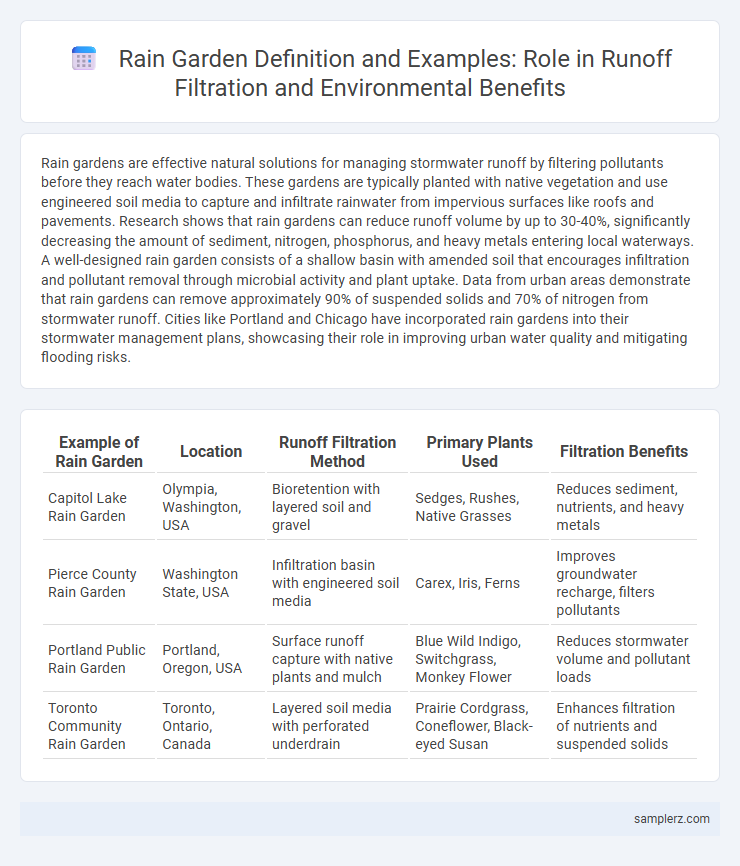Rain gardens are effective natural solutions for managing stormwater runoff by filtering pollutants before they reach water bodies. These gardens are typically planted with native vegetation and use engineered soil media to capture and infiltrate rainwater from impervious surfaces like roofs and pavements. Research shows that rain gardens can reduce runoff volume by up to 30-40%, significantly decreasing the amount of sediment, nitrogen, phosphorus, and heavy metals entering local waterways. A well-designed rain garden consists of a shallow basin with amended soil that encourages infiltration and pollutant removal through microbial activity and plant uptake. Data from urban areas demonstrate that rain gardens can remove approximately 90% of suspended solids and 70% of nitrogen from stormwater runoff. Cities like Portland and Chicago have incorporated rain gardens into their stormwater management plans, showcasing their role in improving urban water quality and mitigating flooding risks.
Table of Comparison
| Example of Rain Garden | Location | Runoff Filtration Method | Primary Plants Used | Filtration Benefits |
|---|---|---|---|---|
| Capitol Lake Rain Garden | Olympia, Washington, USA | Bioretention with layered soil and gravel | Sedges, Rushes, Native Grasses | Reduces sediment, nutrients, and heavy metals |
| Pierce County Rain Garden | Washington State, USA | Infiltration basin with engineered soil media | Carex, Iris, Ferns | Improves groundwater recharge, filters pollutants |
| Portland Public Rain Garden | Portland, Oregon, USA | Surface runoff capture with native plants and mulch | Blue Wild Indigo, Switchgrass, Monkey Flower | Reduces stormwater volume and pollutant loads |
| Toronto Community Rain Garden | Toronto, Ontario, Canada | Layered soil media with perforated underdrain | Prairie Cordgrass, Coneflower, Black-eyed Susan | Enhances filtration of nutrients and suspended solids |
Introduction to Rain Gardens for Runoff Filtration
Rain gardens are specially designed shallow depressions planted with native vegetation to capture and filter stormwater runoff from impervious surfaces like rooftops and parking lots. By promoting infiltration, these gardens reduce the volume of runoff entering storm drains and minimize pollutants such as sediments, nutrients, and heavy metals. Their role in urban water management improves groundwater recharge and mitigates flooding while enhancing local biodiversity.
How Rain Gardens Improve Stormwater Quality
Rain gardens filter stormwater by capturing runoff from impervious surfaces, allowing pollutants like sediments, heavy metals, and nutrients to settle or be absorbed by vegetation and soil microbes. This natural filtration process improves water quality before it reaches local waterways, reducing contamination and mitigating harmful algal blooms. Studies show rain gardens can reduce total suspended solids by up to 90% and nitrogen by 40%, promoting healthier urban ecosystems.
Essential Features of a Rain Garden
A rain garden is designed with essential features such as a shallow depression, native plants, and well-draining soil to effectively filter runoff water. Its vegetation captures pollutants and sediments while soil layers enhance infiltration and reduce overflow into storm drains. Proper placement and sizing ensure optimal absorption and protection of local waterways from urban runoff contamination.
Case Study: Residential Rain Garden Designs
Residential rain garden designs in Portland, Oregon, demonstrate effective runoff filtration by reducing stormwater volume and improving water quality. These gardens use native plants such as Carex and Juncus species, which enhance soil infiltration and filter pollutants like nitrates and heavy metals from surface runoff. Studies show a 30-50% decrease in peak stormwater flow, underscoring rain gardens' role in mitigating urban flooding and protecting local waterways.
Native Plants Used in Rain Gardens
Native plants such as Blue Flag Iris, Switchgrass, and Purple Coneflower are commonly used in rain gardens for their deep root systems that enhance soil infiltration and reduce runoff. These species support local ecosystems by providing habitat for pollinators while efficiently filtering pollutants from stormwater. Incorporating native vegetation in rain gardens promotes sustainable water management and improves watershed health.
Urban Rain Garden Installations for Runoff Control
Urban rain garden installations effectively reduce stormwater runoff by capturing and filtering pollutants through native vegetation and porous soils. Cities like Portland and Philadelphia have implemented rain gardens to mitigate combined sewer overflows and improve water quality. These green infrastructure solutions enhance groundwater recharge while decreasing urban flooding and erosion.
Before-and-After Results: Rain Gardens in Action
Rain gardens significantly improve stormwater runoff filtration by capturing and infiltrating water, reducing pollutants like nitrogen and phosphorus before they reach local waterways. A study in Portland showed a 40% reduction in runoff volume and an 85% decrease in sediment load after rain garden installation. These before-and-after results underscore their effectiveness in enhancing urban water quality and mitigating flood risks.
Cost-Effective Rain Garden Solutions
Rain gardens provide a cost-effective solution for runoff filtration by using native plants and permeable soil to absorb and filter stormwater, reducing the burden on municipal drainage systems. These gardens typically cost between $3 to $10 per square foot to install, significantly lowering expenses compared to traditional stormwater management infrastructure. Incorporating rain gardens into urban planning helps decrease pollutants and mitigate flooding while promoting groundwater recharge at minimal long-term maintenance costs.
Maintenance Tips for Effective Filtration
Regularly removing debris and sediment from the rain garden ensures optimal runoff filtration and prevents clogging of soil pores. Incorporating native plants with deep root systems enhances water infiltration and supports effective contaminant breakdown. Periodic inspection of inflow and outflow areas helps maintain proper water flow and avoids erosion or pooling.
Community Projects: Public Rain Gardens for Water Management
Public rain gardens, such as the Chicago Rain Garden Project, effectively reduce stormwater runoff by filtering pollutants through native plant roots and soil. These community-driven initiatives capture and slow rainwater, mitigating flooding and improving water quality in urban areas. Collaboration between local governments and residents ensures maintenance and maximizes ecological benefits of these rain gardens.

example of rain garden in runoff filtration Infographic
 samplerz.com
samplerz.com